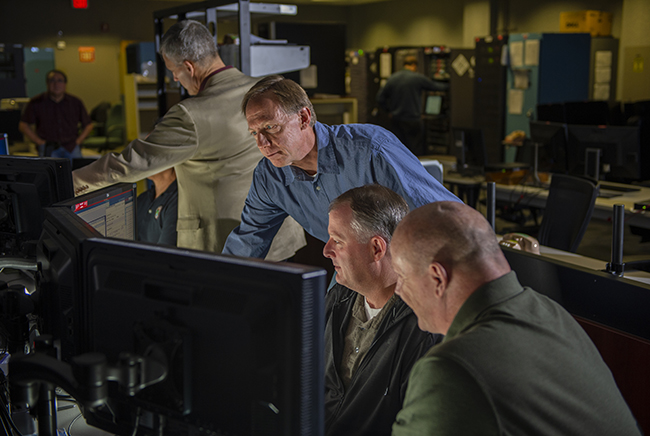
The GPS OCX Ground Systems Engineers monitoring the status of the OCX Block 0 Launch and Checkout System (LCS) located at Schriever AFB, Colo. The LCS system is used to launch and conduct early orbit check out of GPS III satellites. Raytheon courtesy photo.
Four months after Lockheed Martin’s first GPS III satellite launched from Cape Canaveral AFS, Fla., Raytheon says it is changing some aspects of its Operational Control System’s software based on how OCX is performing in real life.
While Block 0 is exceeding the requirements set by the Air Force, Bill Sullivan, Raytheon’s vice president for OCX, said the company is addressing defects and bugs in both the earlier block as well as ensuring they don’t affect Block 1, which is still in development.
Sullivan declined to say what tweaks were made but noted some changes are intended to fix bugs that were discovered and others are done at the Air Force’s request. A couple of weeks ago, the company finished a number of fixes in anticipation of the second GPS III launch this July and more updates will likely occur ahead of the third satellite’s launch in December, he added.
The $5.6 billion OCX program plans to finish building its software this summer for Block 1, which will be able to command and control newer GPS III and IIIF satellites as well as earlier systems, Sullivan said. OCX itself boasts greater cybersecurity, signal strength, accuracy, and anti-jamming capability, as well as the ability to connect to more satellites and shrink operations crew sizes.
Block 1 is expected to start deploying at certain sites like Schriever AFB, Colo., in the third quarter this year, and to be rolled out worldwide by June 2021. At that point, Raytheon will start iteratively developing, testing, and deploying software upgrades on a weekly or monthly basis. The company has adopted faster, automated development and operations techniques, but is keeping the changes in-house until the software is fully ready for release.
The OCX program, which was first slated to enter operations in 2016, has been delayed multiple times and nearly doubled its expected cost. But program officials tout the improvements made under DOD’s oversight, and see 2019 as a pivotal year in the effort’s turnaround.
Operational test and evaluation is now slated for 2023, according to a fiscal 2018 report from the Pentagon’s director for OT&E. Milestone B was declared last September.
“Due to delays in OCX Block 1 delivery, the Air Force initiated the GPS III Contingency Operations program as a ‘bridge capability’ or risk mitigation effort to enable employment of GPS III satellites using legacy (pre-M-Code) signals for operational constellation sustainment until OCX is delivered,” the DOT&E report from January said. “Additionally, M-Code Early Use will deliver early operational use of core M-Code, with full M-Code functionality delivered in OCX Block 1 and 2.”
Block 2 delivery is now merged with Block 1.
The DOT&E report also noted that while Raytheon and the Air Force have made progress in manpower, engineering, and testing since the program’s rising cost triggered a Nunn-McCurdy breach in 2016, “it is unclear the Air Force has enough satellite simulator test resources to conduct developmental testing on GPS III COps [contingency operations] and OCX in parallel, which is required to keep these programs on the current schedule.”
Raytheon’s meetings with Pentagon acquisition chief Ellen Lord, previously held multiple times a year, will shrink to one update later this year, something Sullivan said is a sign the program is on the right track.